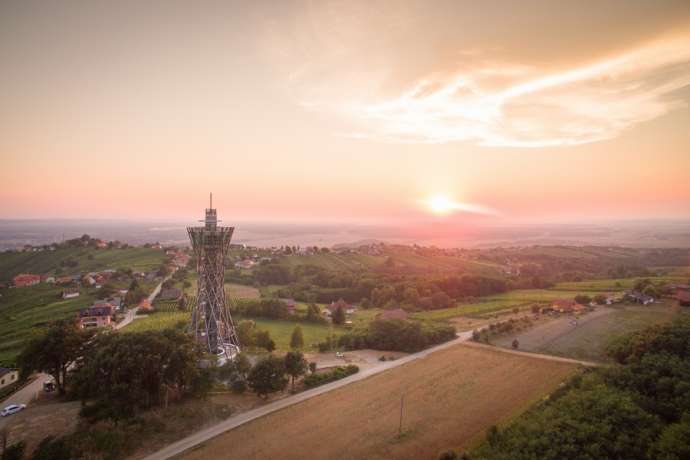STA, 14 August 2019 - Slovenia is observing 100 years since its northeastern-most region of Prekmurje was united with the rest of the nation after World War I and the collapse of the Austro-Hungarian Empire. Located east of the river Mura, Prekmurje was the only territory the Slovenian nation gained at the 1919 Paris Peace Conference.
For nearly a thousand years, Prekmurje was a part of the Kingdom of Hungary, while the remaining Slovenian lands were under Austrian rule.
When the Hapsburg family, the rulers of Austria, took over Hungary in the 16th century, Prekmurje still remained under the Hungarian part of the monarchy, separate from the rest of what is now Slovenia, the Mura etching out a sharp border between the lands up until after World War I.
The peace conference that followed World War I decided that Prekmurje become a part of the then Kingdom of Serbs, Croats and Slovenes on 17 August 1919.
Five days before the date, the royal military occupied the region, handing over the region to the kingdom's civil authorities on the date agreed at the peace talks.
The border between Hungary and the Kingdom of Serbs, Croats and Slovenes was drawn along a demarcation line proposed by Douglas W. Johnson, a cartographer teaching at Columbia University who was a member of the US delegation at the Paris Peace Conference.
He proposed that the border line run north of the Mura, based on statistics provided by Matija Slavič, a member of the Yugoslavian delegation at the conference.
The break-away of Prekmurje from Hungary would not have been possible without a strong national awareness of the people of Prekmurje and the region's well-nourished dialect, according to linguist Klaudija Sedlar, specialising in the region's cultural and historic heritage.
This national fight was also fought along religious lines, with Catholic priests playing a key role against aggressive assimilation launched by Hungary with the help of the Protestant Church in an attempt to preserve its western-most region.
Among other things, catholic priests from the region of Prlekija, just across the Mura, smuggled Slovenian books in barrels across the river in the 19th century, getting some 20,000 books to people living in very modest conditions but nurturing an impressive reading culture.
The Trianon Peace Treaty, which saw Hungary lose two thirds of its territory, also left a part of the Slovenian population in Hungary. A century later, the community living along the Raba river is in no mood to celebrate.
Although recognised as a national minority by Hungary, the community was cut off from its nation and forgotten by Hungary, Andrea Kovacs, the president of the Association of Slovenians in Hungary, has told the STA.
Overnight, the community found itself in a completely different situation, losing writers, teachers, priests, professors and clerks, as Hungarian clerks, teachers and other state staff were sent to the villages along the Raba, launching assimilation that continues today, she said.
"Although they were left to their own devices, our forefathers were very stubborn and this stubbornness helped that we still live in Monošter [Szentgotthard] and seven surrounding villages today," she said.
On the other hand, there was also a Hungarian community left on the Slovenian side of the border, which has consistently refused to celebrate Prekmurje Reunification Day.
This year, however, the minority's MP Ferenc Horvath has accepted the invitation of Slovenia's Prime Minister Marjan Šarec to be a part of a special state committee that prepared the celebrations for the centenary.
He also spoke openly about the sensitive aspects of the anniversary, underlining at the same time that Prekmurje must remain as diverse as it is today at least for the next 100 years.
Recognising that this is a sensitive issue for the Hungarian minority, those preparing the many celebrations have repeatedly said that the celebrations are not designed in opposition to anybody.
Just like a century ago, the biggest events will all take place in Beltinci, a small town south of the region's biggest city, Murska Sobota.
On 17 August 1919, after Sunday mass, the square outside the Beltinci church became the venue of a massive rally that saw more than 20,000 people celebrate the region's unification with the Slovenian nation.
The main event will be the state ceremony on Saturday, which is to be addressed by the prime minister. President Borut Pahor is to address a ceremony organised by the Municipality of Beltinci the night before, as the community has made the reunification also its municipal holiday.
Moreover, the Archbishop of Ljubljana Stanislav Zore will offer mass in Beltinci on Saturday. The mass will likely be the most multicultural event of all, featuring representatives of the Protestant Church and the Hungarian Catholic Church, among others.
On Monday, a new square named after the region will be inaugurated in Ljubljana, while the central bank has issued collectable coins marking the centenary last week.
More than 77,000 people live in Prekmurje on a surface area of nearly 950 square kilometres of what is mainly flat agricultural land dotted with villages.
However, the region's population seems to be shrinking. While the entire country has seen a decrease in the number of newborns, elsewhere the negative population trend has been kept at bay by people moving to Slovenia.
However, Prekmurje, often considered one of the least developed parts of the country, does not make for an attractive destination for many. Statistics show that just over 280 people moved to the region in 2017, while nearly 19,000 people moved to Slovenia that year.
Thus, before the holiday, its native MP Jožef Horvat, proposed to Šarec that a strategic development partnership be set up to create an attractive business environment in which the young would like to work and set up businesses.






